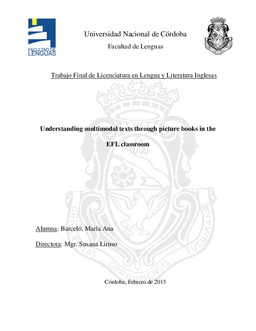| dc.contributor.advisor | Liruso, Susana M. | |
| dc.contributor.author | Barceló, María Ana | |
| dc.date.accessioned | 2016-02-11T17:17:10Z | |
| dc.date.available | 2016-02-11T17:17:10Z | |
| dc.date.issued | 2015 | |
| dc.identifier.uri | http://hdl.handle.net/11086/2293 | |
| dc.description.abstract | New technologies have changed the way in which texts are produced, creating new genres and requiring new skills from the readers. Most texts have become multimodal, which means that they make use of different verbal and visual semiotic systems to create meaning. This paper attempts to show that in the EFL classroom multimodality can be addressed through the picture book, a genre whose characteristics will be explained in this paper. Apart from providing a theoretical framework to understand the concepts of multimodality and how to approach picture books, this research presents the new roles that teachers and students will have to adopt to benefit from the storytelling process and possible classroom uses of such books. | es |
| dc.language.iso | eng | es |
| dc.rights | Atribución-NoComercial-SinDerivadas 2.5 Argentina | * |
| dc.rights.uri | http://creativecommons.org/licenses/by-nc-nd/2.5/ar/ | * |
| dc.subject | Comprensión de texto | es |
| dc.subject | Libros ilustrados para niños | es |
| dc.subject | Inglés como segunda lengua | es |
| dc.title | Understanding multimodal text through picture books in the EFL classroom | es |
| dc.type | bachelorThesis | es |





